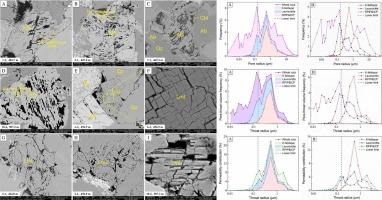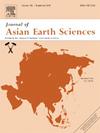鄂尔多斯盆地上三叠统钾长石和烟云母次生孔隙对致密砂岩储层质量的影响
IF 2.4
3区 地球科学
Q2 GEOSCIENCES, MULTIDISCIPLINARY
引用次数: 0
摘要
鄂尔多斯盆地上三叠统延长组长6段为致密砂岩高产储层。除了残余的原生粒间孔隙外,钾长石和湖沸石中的次生孔隙是这些储层孔隙系统的关键组成部分。然而,这些次生孔隙在储层质量中的具体作用尚未量化。本研究将背散射扫描电子显微镜、能谱分析、图像处理和分形分析相结合,对钾长石和云母的次生孔隙结构进行了表征。为了解决量化它们对储层质量贡献的挑战,研究人员开发了一种结合BSEM-EDS、汞侵入毛细管压力(MICP)和核磁共振(NMR)结果的新方法。结果表明,钾长石和湖沸石次生孔隙主要起储层喉道作用,控制储层渗透率。钾长石溶蚀与Na+含量呈负相关,特别是当原生晶间孔隙未被间隙物质完全填充时。地层水中高Ca2+浓度和封闭的成岩环境抑制了溶沸石的溶解。矿物脆性和解理作用显著影响钾长石和钙长石的孔隙结构复杂性。与湖沸石次生孔隙相比,钾长石次生孔隙对储层质量的贡献更大,为致密砂岩储层的“甜点”识别提供了重要的见解。本文章由计算机程序翻译,如有差异,请以英文原文为准。

Effects of secondary pores within K-feldspar and laumontite on the reservoir quality of tight sandstone from the Upper Triassic succession, Ordos Basin, China
The Chang-6 member of the Upper Triassic Yanchang Formation in the Ordos Basin is a productive tight sandstone reservoir. In addition to residual primary intergranular pores, secondary pores within K-feldspar and laumontite are key components of the pore system in these reservoirs. However, the specific roles of these secondary pores in reservoir quality remain unquantified. This study integrated back-scattered scanning electron microscopy with energy dispersive spectrum (BSEM-EDS) analysis, image processing, and fractal analysis to characterize the secondary pore structures within K-feldspar and laumontite. To address challenges in quantifying their contributions to reservoir quality, a novel method combining the results of BSEM-EDS, mercury intrusion capillary pressure (MICP), and nuclear magnetic resonance (NMR) was developed. The results indicate that the secondary pores within K-feldspar and laumontite primarily serve as reservoir throats, controlling reservoir permeability. K-feldspar dissolution exhibits a negative correlation with its Na+ content, especially when primary intergranular pores are incompletely filled by interstitial materials. Laumontite dissolution is inhibited by high Ca2+ concentration in the formation water and a closed diagenetic environment. Mineral brittleness and cleavages significantly influence the pore structure complexity of K-feldspar and laumontite. Compared with laumontite secondary pores, K-feldspar secondary pores contribute more substantially to reservoir quality, providing critical insights for “sweet spot” identification in tight sandstone reservoirs.
求助全文
通过发布文献求助,成功后即可免费获取论文全文。
去求助
来源期刊

Journal of Asian Earth Sciences
地学-地球科学综合
CiteScore
5.90
自引率
10.00%
发文量
324
审稿时长
71 days
期刊介绍:
Journal of Asian Earth Sciences has an open access mirror journal Journal of Asian Earth Sciences: X, sharing the same aims and scope, editorial team, submission system and rigorous peer review.
The Journal of Asian Earth Sciences is an international interdisciplinary journal devoted to all aspects of research related to the solid Earth Sciences of Asia. The Journal publishes high quality, peer-reviewed scientific papers on the regional geology, tectonics, geochemistry and geophysics of Asia. It will be devoted primarily to research papers but short communications relating to new developments of broad interest, reviews and book reviews will also be included. Papers must have international appeal and should present work of more than local significance.
The scope includes deep processes of the Asian continent and its adjacent oceans; seismology and earthquakes; orogeny, magmatism, metamorphism and volcanism; growth, deformation and destruction of the Asian crust; crust-mantle interaction; evolution of life (early life, biostratigraphy, biogeography and mass-extinction); fluids, fluxes and reservoirs of mineral and energy resources; surface processes (weathering, erosion, transport and deposition of sediments) and resulting geomorphology; and the response of the Earth to global climate change as viewed within the Asian continent and surrounding oceans.
 求助内容:
求助内容: 应助结果提醒方式:
应助结果提醒方式:


